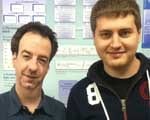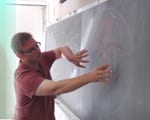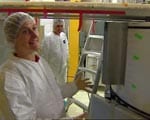Physicists from SMU and around the globe were euphoric Wednesday with the revelation that a new particle consistent with the Higgs boson “God particle” has been observed.
Described as a great triumph for science, the observation is the biggest physics discovery of the last 50 years and opens what scientists said is a vast new frontier for more research.
The achievement is the result of the global CERN scientific collaboration of thousands of scientists, including physicists from SMU, and CERN’s massive $10 billion Large Hadron Collider proton smasher.
“The observation opens up clear directions for physicists at SMU and throughout the world to study the properties of the Higgs,” said SMU physicist Ryszard Stroynowski, a principal investigator in the search for the Higgs and the leader of SMU’s team from the Department of Physics on the experiment.
“The experimental physics group at SMU has been involved since 1994 and is a major contributor to this study. This discovery was many years in the making, but it was worth the wait,” Stroynowski said.
The results, which are preliminary, were announced at CERN, the European Organization for Nuclear Research, near Geneva, Switzerland, and at the International Conference of High Energy Physics in Melbourne, Australia.

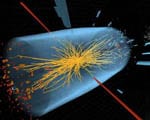
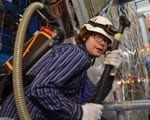




SMU Dean of Dedman College of Humanities and Sciences William M. Tsutsui noted that the crucial work contributed by SMU scientists gives Dallas standing in the discovery.
“Although the world’s eyes are on Switzerland, it is important to remember how much of the expertise driving the revolutionary experiments at CERN came from right here in Dallas,” Tsutsui said. “Distinguished scholars in Dedman College’s Department of Physics, including Ryszard Stroynowski and Jingbo Ye, have played critical roles in the search for the tiniest and most elusive building blocks of the universe.”
Observation is culmination of nearly 50 years of research
In making the announcement, CERN’s scientists stopped short of declaring the new particle the Higgs, saying they will further analyze the data to see whether it is the Higgs boson as originally theorized more than 40 years ago, but which has never been observed through experiments.
A Higgs particle is necessary to round out the fundamental particles that make up physics’ Standard Model, which describes the fundamental particles and their interactions.
Without a Higgs, the Standard Model does not fully explain how the universe emerged from the Big Bang. The Higgs explains how matter acquires mass.
CERN’s Large Hadron Collider along the border of France and Switzerland made it possible to observe evidence of the Higgs by smashing together protons at high energies so their breakup replicates the Big Bang. The LHC, which took a decade to build, started operation in 2010. It is home to the largest high-energy physics experiments in the world, including the ATLAS and CMS particle detectors, which supplied the data for Wednesday’s results.
Scientists from 45 collaborating nations work on the LHC experiments, including more than 1,700 from 89 U.S. universities. They have helped design, build and operate the LHC accelerator and its particle detectors.
LHC’s data equivalent to grains of sand needed to fill Olympic-size pool
The LHC is a 17-mile tunnel some 100 meters below ground. Within the tunnel, billions of protons are sent hurling into one another to re-create the high-energy explosions present at the Big Bang. In those rare instances when protons collide in the LHC tunnel, the smashing protons break up into smaller particles. In a process akin to reverse engineering, the resulting particle sprays are captured as data that are then analyzed for evidence that they emerged from the fundamental Higgs.
In announcing the results, CERN scientists said data taken the past two years represent 500 trillion collisions. That equates to the grains of sand it would take to fill an Olympic-size swimming pool. Within that data, evidence pointing to the Higgs equals an amount of sand covering the tip of a finger, they said.
Discovery made possible by global supercomputing grid that includes SMU
Credit for the discovery goes not only to the scientists and to CERN’s Large Hadron Collider, but also to a vast worldwide computing grid at partnering institutions. Physicists rely on supercomputers to assist their analysis of the massive flow of raw data containing the Higgs.
The SMU High-Performance Computing system is part of that grid and routinely runs data that contributed to the observation, Stroynowski said.
“Much of the success of our small group in the highly competitive environment of a large international collaboration has been due to an easy access and superb performance of the SMU High Performance Computing system,” Stroynowski said. “We used the HPC for fast data analyses and complex calculations needed for the discovery.”
Discovery of the new particle demonstrates the importance of basic research, said James Quick, associate vice president for research at SMU and dean of graduate studies.
“SMU is proud and excited that its Department of Physics has been an active participant in this effort and looks forward to the department’s continued participation at CERN,” he said. “Launched by a federal research project sponsored by Congressman Pete Sessions, high-performance computing at SMU played a role in the Higgs discovery and is a primary focus in the university’s drive to expand research and enhance education.”
Discovery is once-in-a-lifetime milestone for SMU researchers
SMU researchers contribute to the experiment through hardware and software development, as well as by taking operations shifts, both in the control room and in the United States, by remote, and through review of their colleagues’ work.
Besides Stroynowski, the SMU team includes Physics Department researchers Jingbo Ye, Ryan Rios and Julia Hoffman. In addition, physics faculty Robert Kehoe and Stephen Sekula are part of the SMU team. Theoretical faculty include Pavel Nadolsky and Fredrick Olness.
“It’s a very happy day for all of us in particle physics,” said Nadolsky, who with other physicists contributed calculations extensively used by LHC experimentalists, including for discovery of the Higgs boson candidate and for ongoing analyses to establish the properties of the new particle. Those working with him include postdoctoral researchers Marco Guzzi and Jun Gao, graduate student Zhihua Liang, and senior lecturer Simon Dalley.
Other researchers who have participated on the SMU team include Ana Firan, Haleh Hadavand, Sami Kama, Aidan Randle-Conde, Peter Renkel, Rozmin Daya, Renat Ishmukhametov, Tingting Cao and Kamile Dindar-Yagci.
Electronics development was carried out by research professors Andy Liu and Annie Xiang, with computer support by Justin Ross.
“The discovery of the Higgs is a once-in-a-lifetime event; this is the culmination of a 50-year quest,” said Olness, chair of the SMU Physics Department. “The last time a discovery of this import occurred was in 1983 with the observation of the W and Z boson — also at CERN; this achievement was recognized with the 1984 Nobel Prize. Many speculate the discovery of the Higgs boson also merits a Nobel Prize.”
The vast majority of U.S. scientists participate in the LHC experiments from their home institutions, remotely accessing and analyzing the data through high-capacity networks and grid computing.
“The results released on July 4 are truly a ‘team effort,’ not just by SMU but throughout all of ATLAS,” said Sekula, assistant physics professor. “These results are not possible without both the cooperation and competition that are needed to drive scientific innovation and progress.”
Waiting for Higgs for more than half a century
Physicists theorized in 1964 the existence of a new particle, now known as the Higgs, whose coupling with other particles would determine their mass.
SMU’s Kehoe said the observation changes our view of the universe. “It further transforms our daily experience of mass, which is hard and heavy, into the ghostly world of quantum mechanical interactions,” Kehoe said. “If what we are seeing is the Higgs particle, we will have identified the last unknown particle in the Standard Model.”
The Standard Model of particle physics has proved to explain correctly the elementary particles and forces of nature through more than four decades of experimental tests. But it cannot, without the Higgs boson, explain how most of these particles acquire their mass, a key ingredient in the formation of our universe.
CERN reported that both the ATLAS and CMS experiments within the LHC independently observed the new heavy particle in the mass region around 125-126 billion electron volts.
“So far, more than one study indicates an excess, but by a bit more than expected,” Kehoe said. “And the mass is in the range predicted for a Standard Model Higgs. However, measurements from other analyses need also to be brought to bear.”
The preliminary results announced Wednesday are based on data collected in 2011 and 2012, with the 2012 data still under analysis. A more complete picture will emerge later this year after the LHC provides more data.
Scientists to gather more data to learn about new particle
Sekula, who was at CERN and live-blogged Wednesday’s announcement, reported that “the atmosphere in the Main Amphitheater at CERN was electric, and all this energy burst forth in thunderous applause when first CMS, then ATLAS, showed independent and overwhelming evidence for the existence of a new particle in nature, consistent with the Higgs particle. Decades of scientific hope and frustration suddenly turned to joy and excitement — I can only imagine what the future holds as we gather more data and learn more about this particle.”
The CMS and ATLAS experiments in December announced seeing tantalizing hints of a new particle in their hunt for the Higgs. Since resuming data-taking in March 2012, the CMS and ATLAS experiments have more than doubled their collected data.
In the future, physicists will have to determine the properties of the new particle.
“How much does it weigh precisely? What are its quantum mechanical properties?” Kehoe said. “There are several theories that are consistent with what we’ve seen so far, like the theory of supersymmetry, and we need to make careful measurements to tell which one is correct. If what we’re seeing is a new type of particle that only superficially resembles the Higgs right now, then this will revolutionize our understanding of matter and energy at a fundamental level.” — Margaret Allen, CERN, Fermilab
Follow SMUResearch.com on Twitter, http://twitter.com/smuresearch.
SMU is a nationally ranked private university in Dallas founded 100 years ago. Today, SMU enrolls nearly 11,000 students who benefit from the academic opportunities and international reach of seven degree-granting schools. For more information see www.smuresearch.com.
SMU has an uplink facility located on campus for live TV, radio, or online interviews. To speak with an SMU expert or book an SMU guest in the SMU Broadcast Studio, call SMU News & Communications at 214-768-7650.
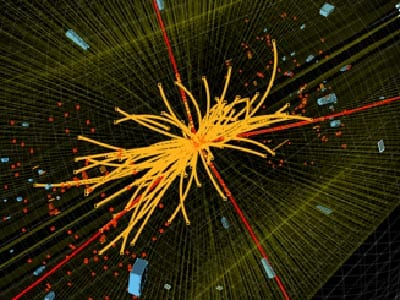

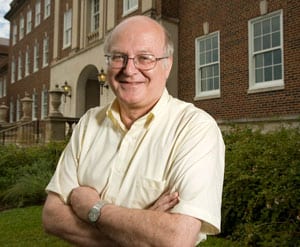
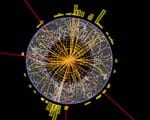 Dallas Observer: Physicists Near Discovery of God Particle
Dallas Observer: Physicists Near Discovery of God Particle
